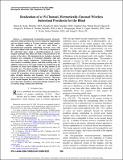Realization of a 15-channel, hermetically-encased wireless subretinal for the blind
Author(s)
Wyatt, John L.; Drohan, William A.; Kelly, Shawn K.; Doyle, Patrick S.; Rizzo, Joseph F.; Cogan, Stuart F.; Theogarajan, Luke S.; Gingerich, Marcus D.; Chen, Jinghua; Shire, Douglas B.; ... Show more Show less
DownloadKelly-2009-Realization of a 15-channel, hermetically-encased wireless subretinal prosthesis for the blind.pdf (854.1Kb)
PUBLISHER_POLICY
Publisher Policy
Article is made available in accordance with the publisher's policy and may be subject to US copyright law. Please refer to the publisher's site for terms of use.
Terms of use
Metadata
Show full item recordAbstract
A miniaturized, hermetically-encased, wirelessly-operated retinal prosthesis has been developed for implantation and pre-clinical studies in Yucatan mini-pig animal models. The prosthesis conforms to the eye and drives a microfabricated polyimide stimulating electrode array with sputtered iridium oxide electrodes. This array is implanted in the subretinal space using a specially-designed ab externo surgical technique that affixes the bulk of the prosthesis to the surface of the sclera. The implanted device includes a hermetic titanium case containing a 15-channel stimulator chip and discrete power supply components. Feedthroughs from the case connect to secondary power- and data-receiving coils. In addition, long-term in vitro pulse testing was performed on the electrodes to ensure their stability for the long lifetime of the hermetic case. The final assembly was tested in vitro to verify wireless operation of the system in biological saline using a custom RF transmitter circuit and primary coils. Stimulation pulse strength, duration and frequency were programmed wirelessly using a custom graphical user interface. Operation of the retinal implant has been verified in vivo in one pig for more than three months by measuring stimulus artifacts on the eye surface using a contact lens electrode.
Date issued
2009-11Department
Massachusetts Institute of Technology. Department of Electrical Engineering and Computer Science; Massachusetts Institute of Technology. Research Laboratory of ElectronicsJournal
Annual International Conference of the IEEE Engineering in Medicine and Biology Society, 2009. EMBC 2009.
Publisher
Institute of Electrical and Electronics Engineers
Citation
Kelly, S.K. et al. “Realization of a 15-channel, hermetically-encased wireless subretinal prosthesis for the blind.” Engineering in Medicine and Biology Society, 2009. EMBC 2009. Annual International Conference of the IEEE. 2009. 200-203. © 2009 IEEE
Version: Final published version
ISBN
978-1-4244-3296-7